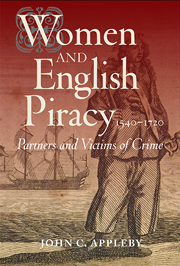Book contents
- Frontmatter
- Contents
- Maps and Illustrations
- Acknowledgements
- A Note on Conventions
- Abbreviations
- Introduction
- 1 The Rise and Fall of English Piracy from the 1540s to the 1720s
- 2 Pirates, Female Receivers and Partners: The Discrete Supporters of Maritime Plunder from the 1540s to the 1640s
- 3 Wives, Partners and Prostitutes: Women and Long-Distance Piracy from the 1640s to the 1720s
- 4 Petitioners and Victims: Women's Experiences from the 1620s to the 1720s
- 5 The Women Pirates: Fact or Fiction?
- Epilogue
- Bibliography
- Index
1 - The Rise and Fall of English Piracy from the 1540s to the 1720s
Published online by Cambridge University Press: 05 October 2013
- Frontmatter
- Contents
- Maps and Illustrations
- Acknowledgements
- A Note on Conventions
- Abbreviations
- Introduction
- 1 The Rise and Fall of English Piracy from the 1540s to the 1720s
- 2 Pirates, Female Receivers and Partners: The Discrete Supporters of Maritime Plunder from the 1540s to the 1640s
- 3 Wives, Partners and Prostitutes: Women and Long-Distance Piracy from the 1640s to the 1720s
- 4 Petitioners and Victims: Women's Experiences from the 1620s to the 1720s
- 5 The Women Pirates: Fact or Fiction?
- Epilogue
- Bibliography
- Index
Summary
The development of English piracy from the 1540s to the 1720s drew on a well-established tradition of seaborne plunder. A pattern of enterprise emerged during the Anglo-French conflicts of the early sixteenth century which laid the basis for future expansion and elaboration. It included an extensive infrastructure of support, enabling piracy to take on the appearance of a business and commercial operation. Thereafter its growth was sustained by war and international rivalry, particularly with Spain, often in association with lawful forms of sea-roving. The link between piracy and reprisal venturing or privateering was an enduring characteristic of the period. According to captain Charles Johnson, whose General History of the Pyrates published in 1724 provided testimony of public interest in the subject, pirate leaders such as Edward Teach, the infamous Blackbeard of legend, and the women pirates, Anne Bonny and Mary Read, served on both kinds of ventures. Careers that criss-crossed the boundary between the lawful and unlawful indicate the contested nature of piracy as a crime, which provoked varied responses. It flourished within the uncertain, negotiated space between war, policy and maritime plunder.
Piracy developed as a dynamic, but unstable enterprise, thriving on ambiguity or adversity. It was encouraged by international conflict and rivalries, and fuelled by socio-economic dislocation and distress within a world of widening horizons and changing opportunities. While it fed off commerce, following in the path of its expansion within and beyond Europe, piracy exploited weakness.
- Type
- Chapter
- Information
- Women and English Piracy, 1540-1720Partners and Victims of Crime, pp. 8 - 50Publisher: Boydell & BrewerPrint publication year: 2013



